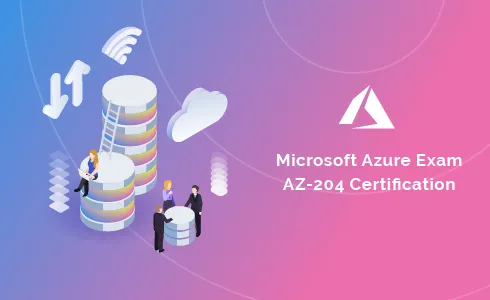





| No. | Domain | Total Question | Correct | Incorrect | Unattempted | Marked for Review |
|---|---|---|---|---|---|---|
| 1 | Develop Azure compute solutions | 13 | 0 | 0 | 13 | 0 |
| 2 | Develop for Azure storage | 18 | 0 | 0 | 18 | 0 |
| 3 | Implement Azure security | 1 | 0 | 0 | 1 | 0 |
| 4 | Monitor, troubleshoot, and optimize Azure solutions | 9 | 0 | 0 | 9 | 0 |
| 5 | Connect to and consume Azure services and third-party services | 14 | 0 | 0 | 14 | 0 |
| Total | All Domains | 55 | 0 | 0 | 55 | 0 |
A software company is developing a software solution. The software solution is for a food delivery-based company. The software needs to adhere to the following workflow
- A driver selects the restaurants for which they will deliver orders.
- Orders are sent to all available drivers in an area.
- Only orders for the selected restaurants will appear for the driver.
- The first driver to accept an order removes it from the list of available orders.
The application needs to make use of the Azure Service Bus service.
Which of the following actions would you implement for this requirement? Choose 3 answers from the options given below
- A. Create a Service Bus topic for each restaurant for which a driver can receive messages.
- B. Create a single Service Bus topic
- C. Create a single Service Bus subscription
- D. Create a single Service Bus Namespace
- E. Create a Service Bus Namespace for each restaurant for which a driver can receive messages.
- F. Create a Service Bus Subscription for each restaurant for which a driver can receive messages.
Explanation:
Answer – B, D and F
We need to create Namespace first then Topics and finally Subscription as following flow chart

You should first create a Service Bus Namespace. Option E is incorrect since creating a Namespace for each restaurant would just be a maintenance overhead and difficult to keep track of via a program.
Here since the driver needs to choose the restaurant, that means the driver can be a subscriber.
Here you should have just one Topic. If you have multiple topics, then an order needs to be sent to all topics. Then deleting an order once it has been picked by a driver will an issue. So, Option A gets ruled out.
You can create subscriptions and create rules based on driver and area.
For more information on Azure Service Bus, one can go to the below link
A company has an application that provides product data to external consultants.
Azure API Management is used to publish API's to the consultants.
The API needs to meet the following requirements
- Support alternative input parameters.
- Remove formatting text from responses.
- Provide additional context to back-end services.
Which type of policy would you use for the following requirement
"Rewrite the request URL to match to the format expected by the web service"
- A. Inbound
- B. Outbound
- C. Backend
- D. Error
Explanation:
Answer – A
An example of this is given in the Microsoft documentation
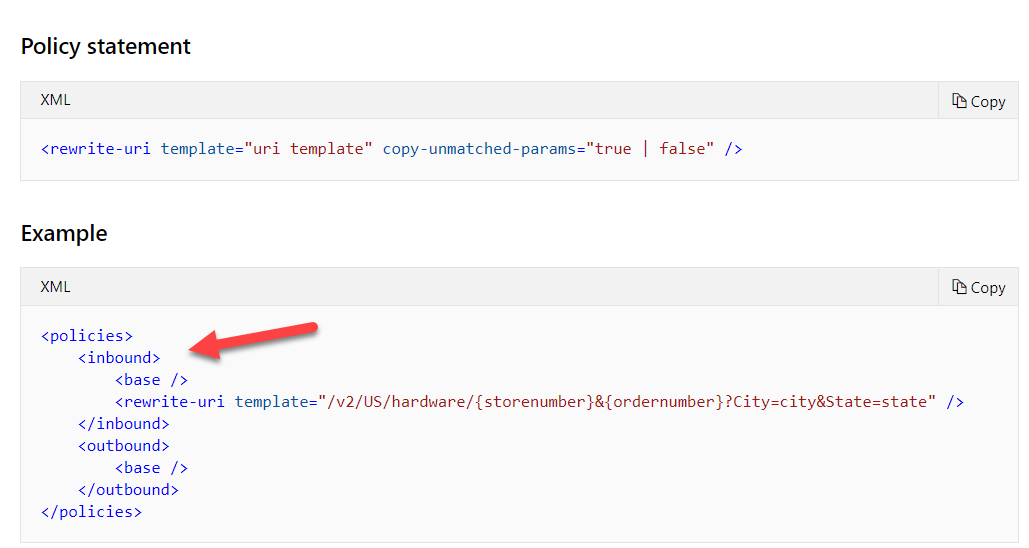
Since this is clearly mentioned, all other options are incorrect
For more information on API management transformation URL’s, one can go to the below link
A company has an application that provides product data to external consultants.
Azure API Management is used to publish API's to the consultants.
The API needs to meet the following requirements
- Support alternative input parameters.
- Remove formatting text from responses.
- Provide additional context to back-end services.
Which type of policy would you use for the following requirement
"Remove formatting text from responses"
- A. Inbound
- B. Outbound
- C. Backend
- D. Error
Explanation:
Answer - B
You can use policy expressions and find and replace to format the text in the response. An example of this is given in the Microsoft documentation
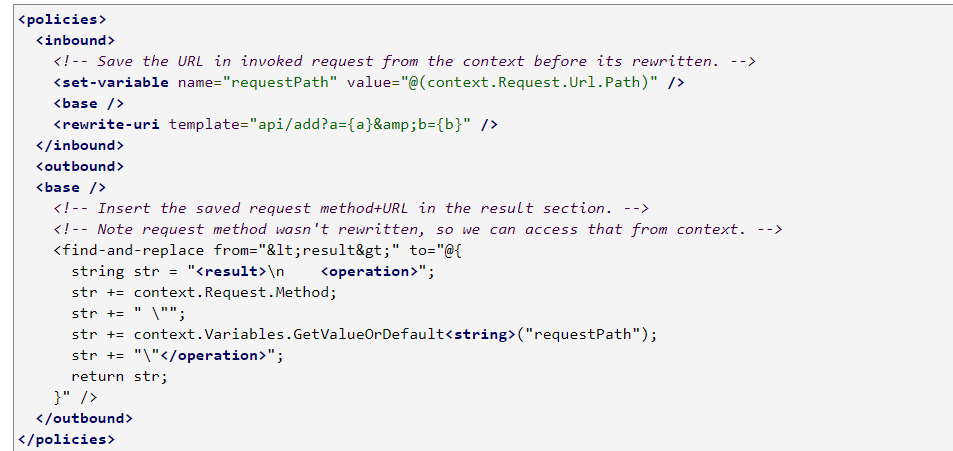
Since this is clearly mentioned, all other options are incorrect
For more information on API management transformation URL’s and a blog article on the same, one can go to the below link
A company has an application that provides product data to external consultants.
Azure API Management is used to publish API's to the consultants.
The API needs to meet the following requirements
- Support alternative input parameters.
- Remove formatting text from responses.
- Provide additional context to back-end services.
Which type of policy would you use for the following requirement
"Forward the user ID that is associated with the subscription key for the original request to the back-end service"
- A. Inbound
- B. Outbound
- C. Backend
- D. Error
Explanation:
Answer - A
An example of this is given in the Microsoft documentation
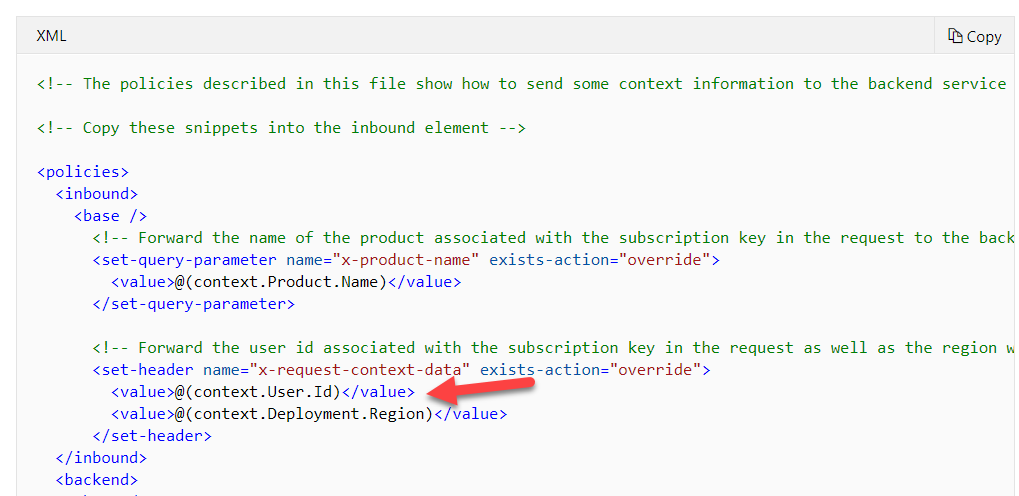
Since this is clearly mentioned, all other options are incorrect
For more information on API management transformation URL’s, one can go to the below link
A development team has published an ASP.Net Web Application to the Azure Web App Service. They are also using Application Insights for the Web App for monitoring purposes and want to monitor telemetry data. They have to ensure that the cost of Application Insights does not exceed a pre-set budget. Which of the following would you implement to adhere to this requirement?
- A. Implement ingestion sampling using the Azure portal.
- B. Set a daily cap for the Application Insights instance.
- C. Implement adaptive sampling using the Azure portal.
- D. Implement adaptive sampling using the Application Insights SDK.
- E. Implement ingestion sampling using the Application Insights SDK.
Explanation:
Answer – D
Adaptive sampling is the default for the ASP.NET SDK. Adaptive sampling automatically adjusts to the volume of telemetry that your app sends. It operates automatically in the SDK in your web app so that telemetry traffic on the network is reduced.
Option B: Daily Cap is also a possible answer, but it has a major disadvantage. In case of data capacity is exhausted at any point during the day, then rest of the day, no data will be ingested and hence in case of any problem in the VM will not be notified. Hence this is not recommended.
For more information on managing costs for Application Insights, one can go to the below link
https://docs.microsoft.com/en-us/azure/azure-monitor/app/pricing#managing-your-data-volume
A development team is developing an application. The application will be working with customer data. The application will also be making use of Azure Cache for Redis. You need to invalidate the cache when the customer data is changed.
You have to complete the below code to comply with the requirement
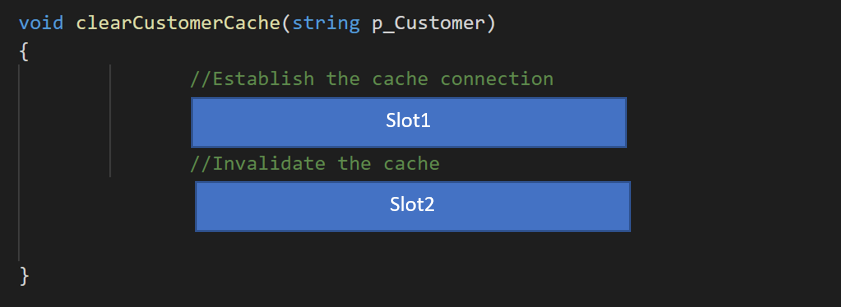
Which of the following will go into Slot1?
- A. IDatabase cache=Connection.GetDatabase();
- B. IDatabase cache=Connection.GetCache();
- C. ICache cache=Connection.GetDatabase();
- D. ICache cache=Connection.GetCache();
Explanation:
Answer – A
The right way is to use the IDatabase interface. Also, you need to use the GetDatabase() method. This is also mentioned in the Microsoft documentation.

Since this is clearly given in the Microsoft documentation, all other options are incorrect
For more information on an example on how to work with Azure Cache for Redis from .Net, one can go to the below link
A development team is developing an application. The application will be working with customer data. The application will also be making use of Azure Cache for Redis. You need to invalidate the cache when the customer data is changed.
You have to complete the below code to comply with the requirement
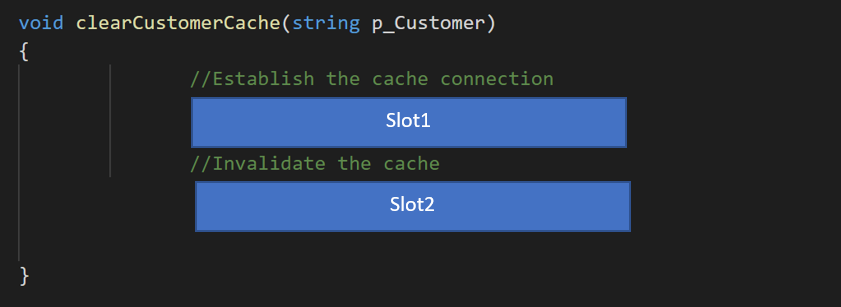
Which of the following will go into Slot2?
- A. cache.KeyDelete(p_Customer);
- B. cache.ValueDelete(p_Customer);
- C. cache.StringGet(p_Customer);
- D. cache.StringSet(p_Customer);
Explanation:
Answer – A
Since you have to invalidate the cache, you have to delete the Key itself
Option B is incorrect since you need to work with keys and not the values
Option C is incorrect this is used to get the string value
Option D is incorrect this is used to set the string value
For more information on an example on how to work with Azure Cache for Redis from .Net, one can go to the below link
You have to load data into a cache in order to improve the performance and maintain data consistency between data store and data in cache. Which of the following are suitable scenarios to use Cache-Aside pattern? Choose 2 answers from the options given below.
- A. Static cached data which can be fit on startup
- B. Native read-through and write-through cache operations are not provided
- C. Unpredictable resource demand.
- D. Caching session state information hosted in a web farm.
Explanation:
Correct Answers: B and C
- Option B is CORRECT because Cache-Aside pattern is suitable for cache which doesn’t provide read-through and write-through operation in native.
- Option C is CORRECT because using the Cache-Aside pattern enables applications to load data on demand. If the resource demand is unpredictable, it is suggested to use the Cache-Aside pattern.
- Option A is incorrect because if the cached data set is static, the data can be cached during startup and apply a policy to prevent the data from expiring.
- Option D is incorrect because developers should avoid introducing dependencies when caching session state information in a web farm.
A company is developing a solution that allows smart devices to send information to a central location. The solution must receive and store messages until they can be processed. You are requested to create an Azure Service Bus Namespace.
Which Azure CLI command or PowerShell CmdLet should you run?
- A. New-AzServiceBusNamespace -ResourceGroupName "whizlabs-rg" -Location "EastUS" -Name "whizlabsnamespace" -SkuName "Standard"
- B. az group create --name "whizlabs-rg" --location "Central US"
- C. New-AzResourceGroup -Name "whizlabs-rg" -Location "Central US"
- D. New-AzServiceBusNamespace -ResourceGroup "whizlabs-rg" -NamespaceName "whizlabs" -Location "WestUS" -SkuName "Standard"
Explanation:
Answer – A
We need to create an Azure Service Buse Namespace
The full syntax in powershell is given at
New-AzServiceBusNamespace
[-ResourceGroupName] <String>
[-Location] <String>
[-Name] <String>
[-SkuName <String>]
[-SkuCapacity <Int32>]
[-Tag <Hashtable>]
[-DefaultProfile <IAzureContextContainer>]
[-WhatIf]
[-Confirm]
[<CommonParameters>]
Hence Option A is correct answer
A team needs to create an Azure CosmosDB account and ensure that regional failovers are in place for the account. Which of the following is a valid CLI command for the creation of the CosmosDB account?
- A. az cosmosdb Create \ --name "whizlabscosmosdb" \ --resource-group "whizlabs-rg" \ --locations regionName=eastus failoverPriority=0 isZoneRedundant=False \ --locations regionName=uksouth failoverPriority=1 isZoneRedundant=True \ --enable-multiple-write-locations
- B. az cosmosdb update \ --name "whizlabscosmosdb" \ --resource-group "whizlabs-rg" \ --locations 3
- C. az cosmosdb create \ --name "whizlabscosmosdb" \ --resource-group "whizlabs-rg" \ --locations "South Central US"=3
- D. az cosmosdb update \ --name "whizlcreateabscosmosdb" \ --resource-group "whizlabs-rg" \ --enable-locations
Explanation:
Answer – A
The Microsoft documentation mentions the correct CLI command to use for ensuring a Cosmos DB account is created in multiple regions
the full syntax is as follows
az cosmosdb create --name
--resource-group
[--capabilities]
[--default-consistency-level {BoundedStaleness, ConsistentPrefix, Eventual, Session, Strong}]
[--disable-key-based-metadata-write-access {false, true}]
[--enable-analytical-storage {false, true}]
[--enable-automatic-failover {false, true}]
[--enable-free-tier {false, true}]
[--enable-multiple-write-locations {false, true}]
[--enable-public-network {false, true}]
[--enable-virtual-network {false, true}]
[--ip-range-filter]
[--key-uri]
[--kind {GlobalDocumentDB, MongoDB, Parse}]
[--locations]
[--max-interval]
[--max-staleness-prefix]
[--server-version {3.2, 3.6}]
[--subscription]
[--tags]
[--virtual-network-rules]
Since this is clearly mentioned, all other options are incorrect
For more information on how to enable multi-region for CosmosDB, one can go to the below link
A developer has setup a web application in Azure and also setup Azure CDN to route requests to the Web App. One of the requirements is to ensure that if users make requests based on passing an ID parameter, then those requests should always be served from a Point of Presence. An example of the URL is given below
Which of the following mode should be set for the query string setting for the CDN service?
- A. Ignore query strings
- B. Default setting
- C. Bypass caching
- D. Cache every unique URL
Explanation:
Answer - D
Below are the different settings available for the CDN when it comes to caching of the query string.
Since we need to ensure that query strings are cached, we have to choose the option of ‘Cache every unique URL’
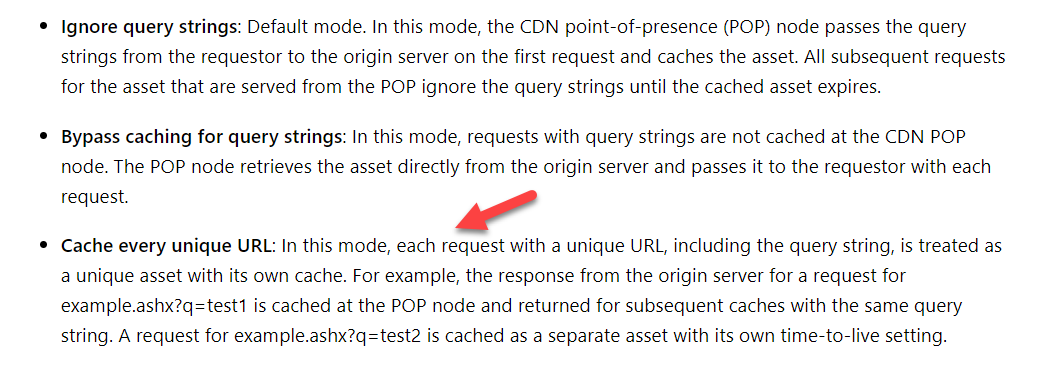
Since this is the ideal approach, all other options are incorrect
For more information on working with query strings for CDN, one can go to the below link
A developer needs to run a set of Azure CLI commands to create a virtual machine. You need to complete the below set of commands.
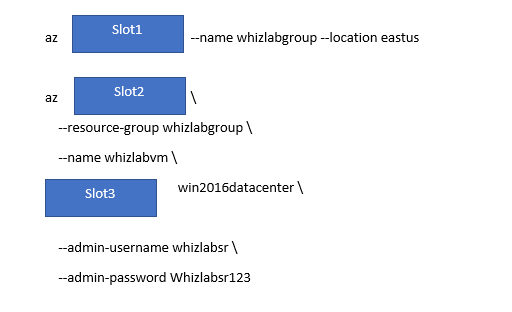
Which of the following would go into Slot1?
- A. vm create
- B. group create
- C. vm set
- D. group set
Explanation:
Answer – B
An example of this is given in the Microsoft documentation. The first step is to ensure that you create a resource group via the az group create CLI command
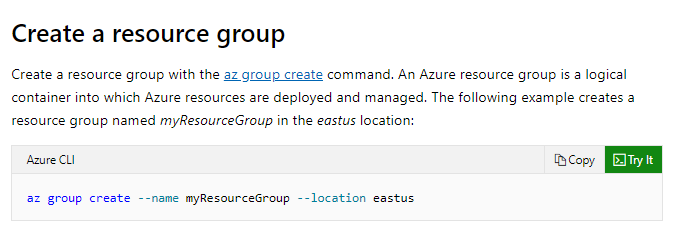
Since this is clearly mentioned in the documentation, all other options are incorrect
For more information on using Azure CLI commands to create virtual machines, please visit the below URL
A developer needs to run a set of Azure CLI commands to create a virtual machine. You need to complete the below set of commands.
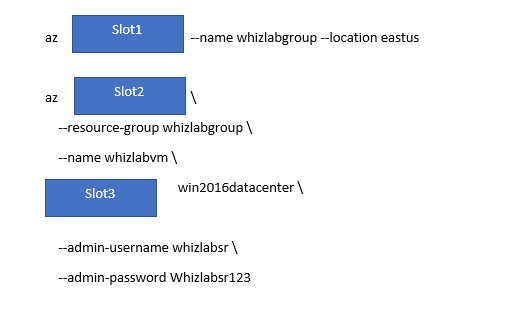
Which of the following would go into Slot2?
- A. vm create
- B. group create
- C. vm set
- D. group set
Explanation:
Answer – A
An example of this is given in the Microsoft documentation. The next step is to ensure that you create the virtual machine via the vm create CLI command
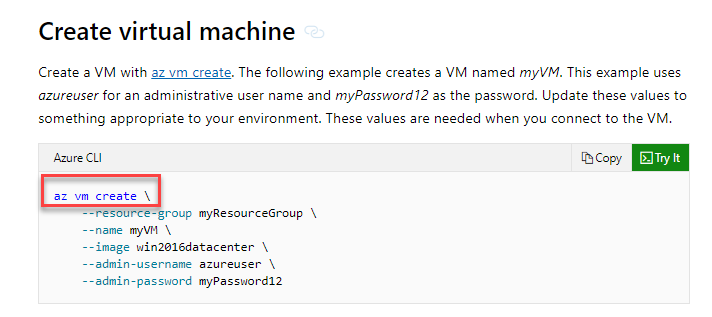
Since this is clearly mentioned in the documentation, all other options are incorrect
For more information on using Azure CLI commands to create virtual machines, please visit the below URL
A developer needs to run a set of Azure CLI commands to create a virtual machine. You need to complete the below set of commands.
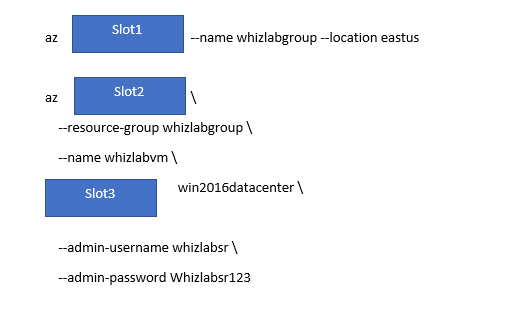
Which of the following would go into Slot3?
- A. --image
- B. --edition
- C. --version
- D. --create
Explanation:
Answer – A
Here, we are mentioning that the image name should be Windows Server 2016. An example of this is provided in the Microsoft documentation
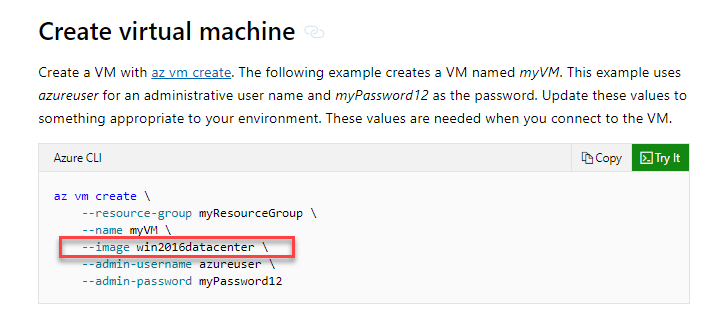
Since this is clearly mentioned in the documentation, all other options are incorrect
For more information on using Azure CLI commands to create virtual machines, please visit the below URL
Your company has a set of Azure storage accounts. These storage accounts store blob objects. You have to move the blobs from one container to another across storage accounts.
You have to use the right tool to perform the movement of data.
You decide to use the AzCopy tool to implement this requirement
Would this fulfil the requirement?
- A. Yes
- B. No
Explanation:
Answer – A
Yes, you can use the AzCopy tool for this requirement
The Microsoft documentation mentions the following

For more information on the AzCopy tool, please refer to the below link
Your company has a set of Azure storage accounts. These storage accounts store blob objects. You have to move the blobs from one container to another across storage accounts.
You have to use the right tool to perform the movement of data.
You decide to use the Azure CLI tool to implement this requirement
Would this fulfil the requirement?
- A. Yes
- B. No
Explanation:
Answer – A
Yes, you can also use the Azure CLI tool for this requirement
The below command can be used for this requirement
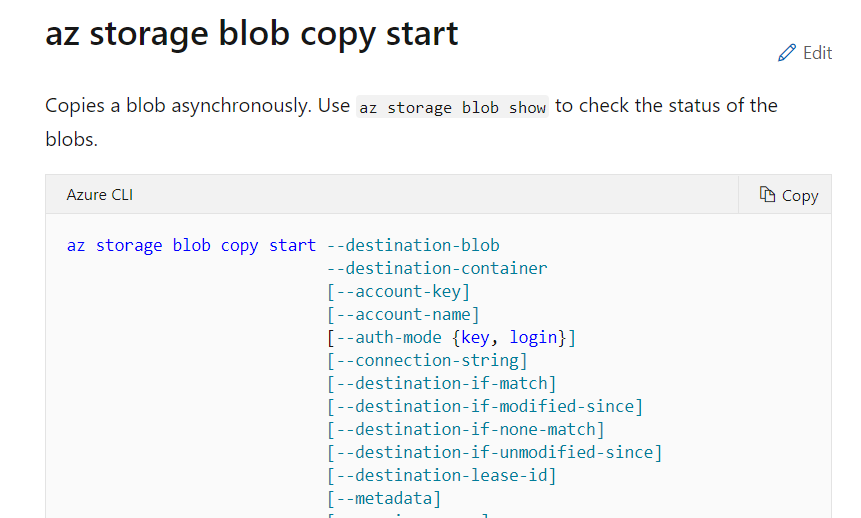
For more information on the Azure CLI command, please refer to the below link
Your company has a set of Azure storage accounts. These storage accounts store blob objects. You have to move the blobs from one container to another across storage accounts.
You have to use the right tool to perform the movement of data.
You decide to use the PowerShell tool to implement this requirement
Would this fulfil the requirement?
- A. Yes
- B. No
Explanation:
Answer – A
Yes, you can also use the PowerShell tool for this requirement
The below command can be used for this requirement
Start-AzStorageBlobCopy
[-SrcBlob] <String>
-SrcContainer <String>
-DestContainer <String>
[-DestBlob <String>]
[-PremiumPageBlobTier <PremiumPageBlobTier>]
[-StandardBlobTier <String>]
[-RehydratePriority <RehydratePriority>]
[-Context <IStorageContext>]
[-DestContext <IStorageContext>]
[-Force]
[-ServerTimeoutPerRequest <Int32>]
[-ClientTimeoutPerRequest <Int32>]
[-DefaultProfile <IAzureContextContainer>]
[-ConcurrentTaskCount <Int32>]
[-WhatIf]
[-Confirm]
[<CommonParameters>]
For more information on the PowerShell command, please refer to the below link
Your team has an Azure container registry in place. You need to provide a set of developers the ability to publish images to registry. You need to ensure the least privilege access is given to the developers. Which of the following role would you give for this purpose?
- A. Owner
- B. Contributor
- C. AcrPush
- D. AcrPull
Explanation:
Answer – C
You would provide the AcrPush role. The different roles are given in the Microsoft documentation
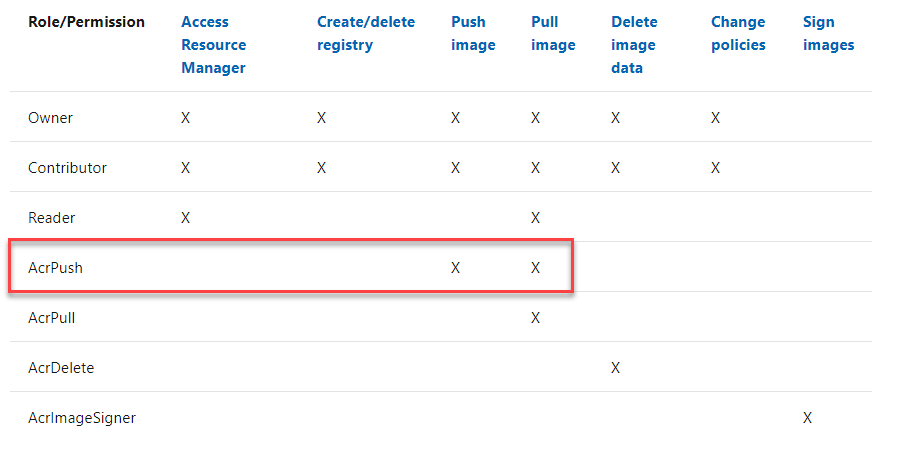
Options A and B are incorrect because these roles would give more access than what is required.
Option D is incorrect because this does not provide the ability to push images to the registry.
For more information on Azure container registry roles, please visit the following URL
A company is currently looking at using Azure storage accounts as a data storage platform. They want to be able to store documents that would need to be retained for around a year. They want to minimize the cost of storage. These documents are rarely accessed..
Which of the following tier would you use for storing the files?
- A. Hot
- B. Cool
- C. Archive
- D. Secondary
Explanation:
Answer – C
In the BLOB service, you can use the Archive tier to store archive documents that can save on costs. The Microsoft documentation mentions the following
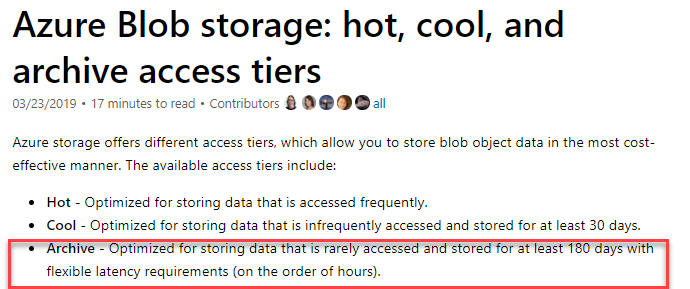
Options A and B are incorrect since these are not cost-efficient options for storing archive-based files.
Option D is incorrect since this is not a valid based tier.
For more information on blob storage tiers, please visit the below URL
A company is currently looking at using Azure storage accounts as a data storage platform. They want to be able to store documents that would need to be retained for around a year. They want to minimize the cost of storage. These documents are not accessed that frequently.
If you need to retrieve an object in Azure BLOB Archive storage, which of the following would need to be done first?
- A. Change the access permissions
- B. Change the tier of the object
- C. Change the account kind
- D. Change the access keys
Explanation:
Answer – B
You need to change the tier of the object. This is also mentioned in the Microsoft documentation
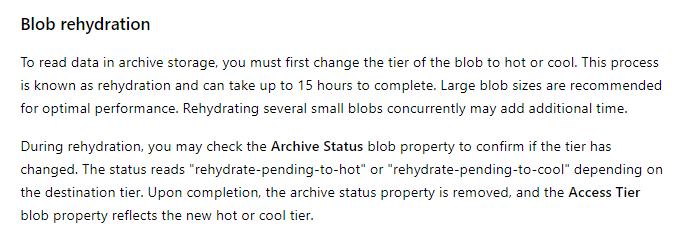
Since this is clearly mentioned in the documentation, all other options are incorrect
For more information on blob storage tiers, please visit the below URL
A developer has been assigned a task to create code that would interact with an Azure Cache for Redis instance. Objects of the following class need to be uploaded to the Azure Cache for Redis database
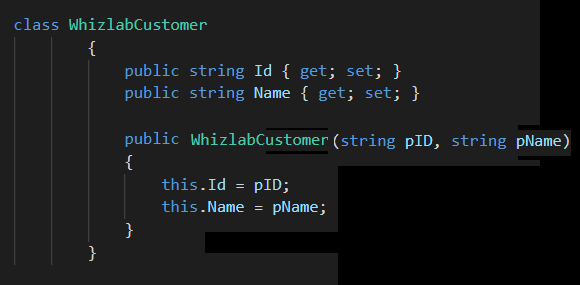
You need to complete the below code snippet
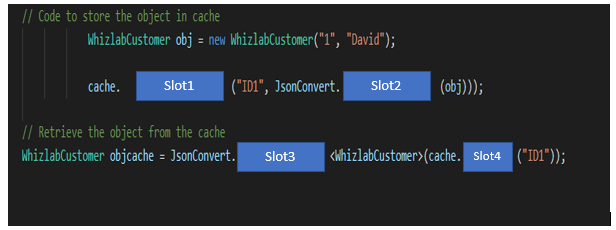
Which of the following would go into Slot1?
- A. ObjectSet
- B. StringSet
- C. ClassSet
- D. Set
Explanation:
Answer – B
To Add an object to the cache database, we need to use the StringSet Method. An example of this is also given in the Microsoft documentation
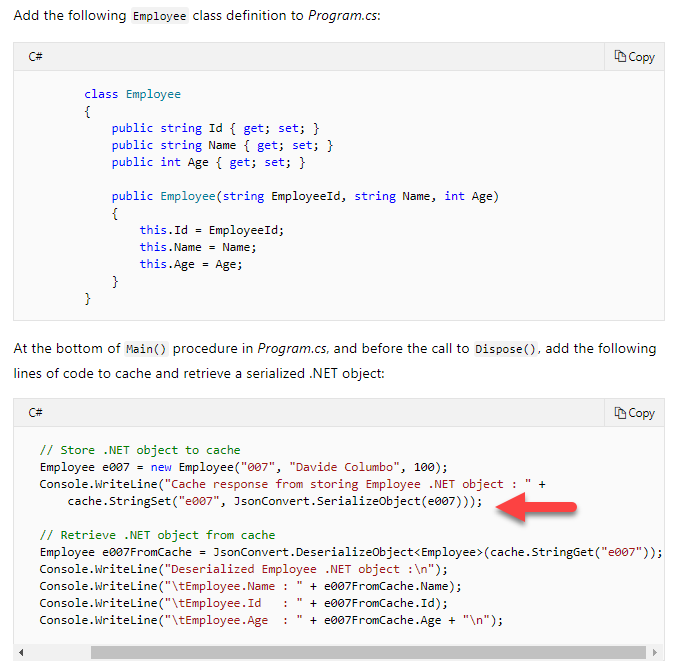
Since this is clearly given in the Microsoft documentation, all other options are incorrect
For more information on how to work with Azure Cache for Redis from a .Net program, please visit the below URL
A developer has been assigned a task to create code that would interact with an Azure Cache for Redis instance. Objects of the following class need to be uploaded to the Azure Cache for Redis database

You need to complete the below code snippet
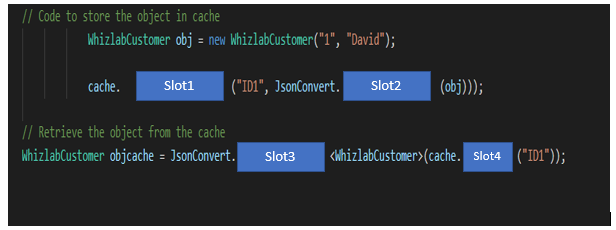
Which of the following would go into Slot2?
- A. SetObject
- B. SerializeObject
- C. GetObject
- D. SerializeClass
Explanation:
Answer – B
We need to serialize the object before it can be added to the redis cache database.
An example of this is also given in the Microsoft documentation
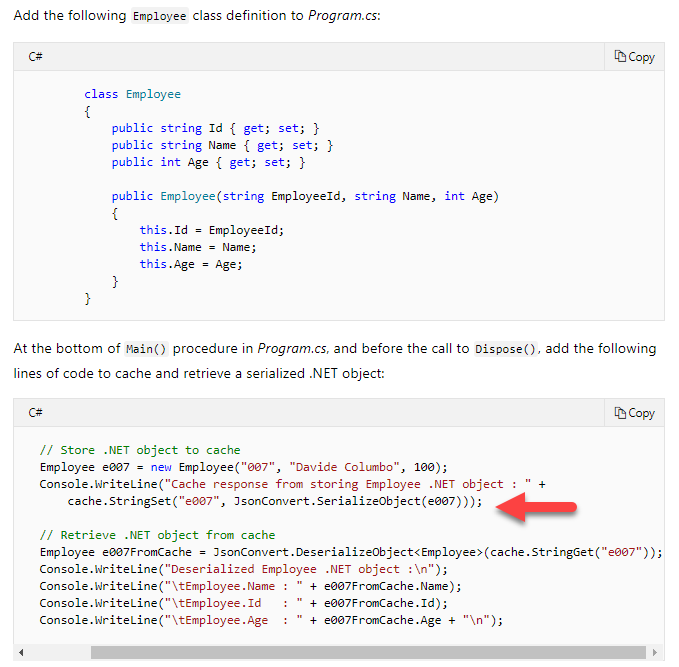
Since this is clearly given in the Microsoft documentation, all other options are incorrect
For more information on how to work with Azure Cache for Redis from a .Net program, please visit the below URL
A developer has been assigned a task to create code that would interact with an Azure Cache for Redis instance. Objects of the following class need to be uploaded to the Azure Cache for Redis database

You need to complete the below code snippet
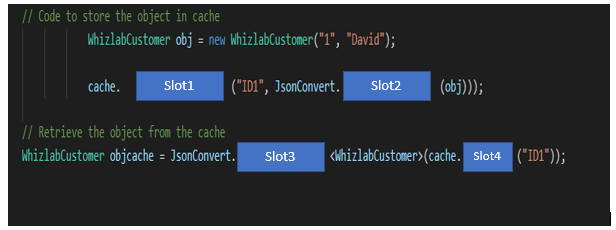
Which of the following would go into Slot3?
- A. SetObject
- B. DeserializeObject
- C. GetObject
- D. DeserializeClass
Explanation:
Answer – B
We need to use the deserialize method to convert the object retrieved from the cache
An example of this is also given in the Microsoft documentation
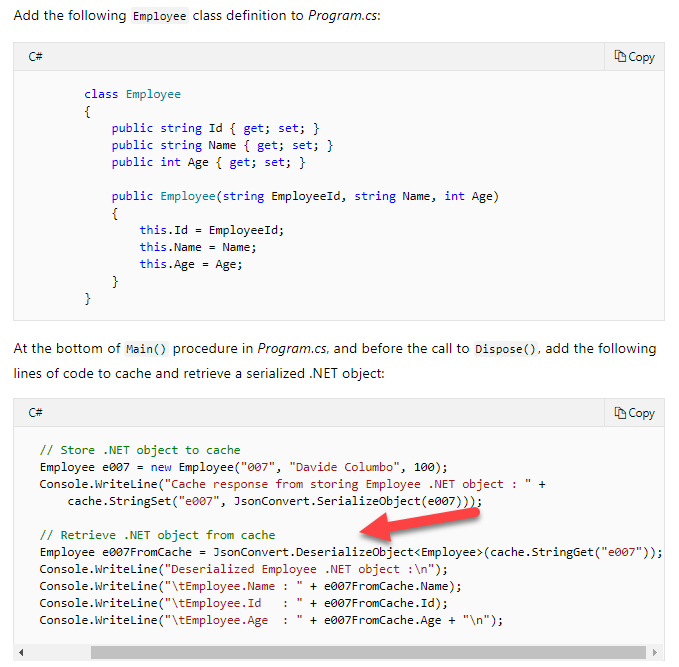
Since this is clearly given in the Microsoft documentation, all other options are incorrect
For more information on how to work with Azure Cache for Redis from a .Net program, please visit the below URL
A developer has been assigned a task to create code that would interact with an Azure Cache for Redis instance. Objects of the following class need to be uploaded to the Azure Cache for Redis database

You need to complete the below code snippet
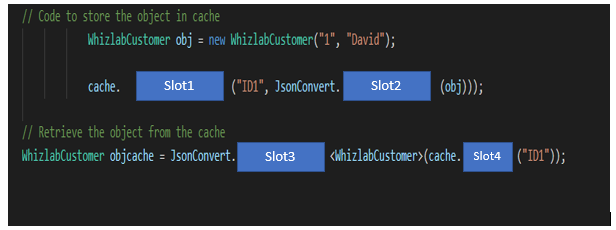
Which of the following would go into Slot4?
- A. ObjectGet
- B. StringSet
- C. ClassSet
- D. StringGet
Explanation:
Answer – D
We need to get an object from the cache, so we should use the StringGet method.
An example of this is also given in the Microsoft documentation
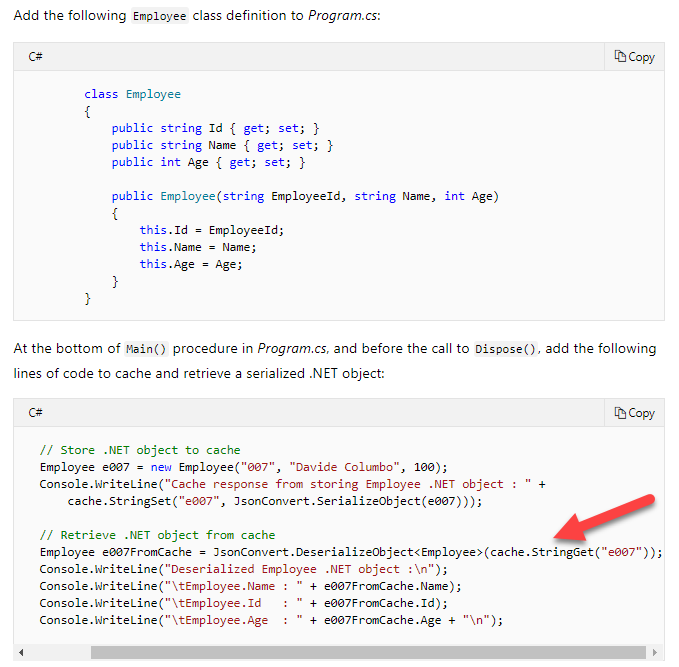
Since this is clearly given in the Microsoft documentation, all other options are incorrect
For more information on how to work with Azure Cache for Redis from a .Net program, please visit the below URL
A company is developing a system which is going to be using Azure Cosmos DB at the underlying data store. Below are the requirements of the data store
- Ensure at least 99.99% availability and provide low latency
- Accept reservations event when localized network outages or other unforeseen failures occur.
- Process data in the same sequence as the writes being made
- Allow out of order data with a maximum of 5 second tolerance window
You have to provision a Cosmos DB account – SQL API. You already have a resource group in the South Central US region.
You have to complete the below Azure CLI commands for this purpose.
 Which of the following would go into Slot1?
Which of the following would go into Slot1?
- A. Strong
- B. Eventual
- C. ConsistentPrefix
- D. BoundedStaleness
Explanation:
Answer – D
Since you can have an out of order read for a maximum of 5 seconds, this becomes our staleness window.
The Microsoft documentation mentions the following on the Bounded Staleness consistency level.
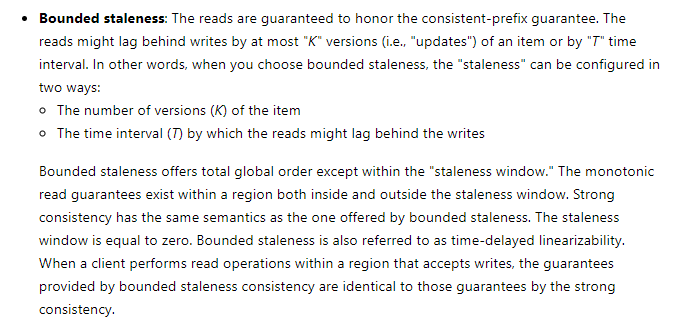
Since this is clearly given in the Microsoft documentation, all other options are incorrect
For more information on consistency levels, please visit the below URL
A company is developing a system which is going to be using Azure Cosmos DB at the underlying data store. Below are the requirements of the data store
- Ensure at least 99.99% availability and provide network failures
- Accepts writes via the application even in the case of network outages or any unforeseen failures
- Process data in the same sequence as the writes being made
- Allow out of order data with a maximum of 5 second tolerance window
You have to provision a Cosmos DB account – SQL API. You already have a resource group in the South Central US region.
You have to complete the below Azure CLI commands for this purpose.

Which of the following would go into Slot2?
- A. --enable-virtual-network true
- B. --enable-automatic-failover true
- C. --kind ‘GlobalDocumentDB’
- D. --kind ‘MongoDB’
Explanation:
Answer – B
Since we have to ensure that the data needs to be available even in the case of network outages or any unforeseen failures, we have to enable automatic failover.
The Microsoft documentation mentions the following

Option A is incorrect since there is no mention in the question of requiring the database to be part of a virtual network
Option C is incorrect since the default API chosen for the database is the SQL API
Option D is incorrect since we need to create a Cosmos DB account with the SQL API
For more information on the Cosmos DB create command, please visit the below URL
A company is developing a system which is going to be using Azure Cosmos DB at the underlying data store. Below are the requirements of the data store
- Ensure at least 99.99% availability and provide network failures
- Accepts writes via the application even in the case of network outages or any unforeseen failures
- Process data in the same sequence as the writes being made
- Allow out of order data with a maximum of 5 second tolerance window
You have to provision a Cosmos DB account – SQL API. You already have a resource group in the South Central US region.
You have to complete the below Azure CLI commands for this purpose.
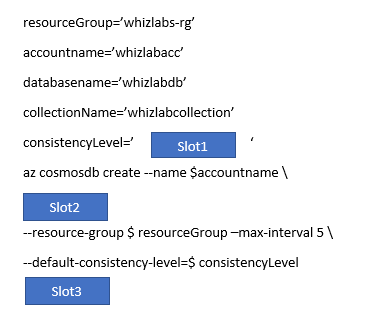
Which of the following would go into Slot3?
- A. --locations ‘southcentralus’
- B. --locations ‘eastus’
- C. --locations "SouthCentralUS=0", "NorthCentralUS=1"
- D. --locations ‘southcentralus=0’
Explanation:
Answer – C
Since we need to have additional regions for failover purposes, we need to add multiple locations to the Cosmos DB account.
And keep in mind for failover purpose, the region should be mapped correctly
The paired region for "South Central US" is "North Central US"
The other options are incorrect since they only have one location specified.
For more information on the Cosmos DB create command, please visit the below URL
You have to implement the azcopy tool to copy objects from a local folder named D:\whizlabs to a container named “demo” within the below storage account
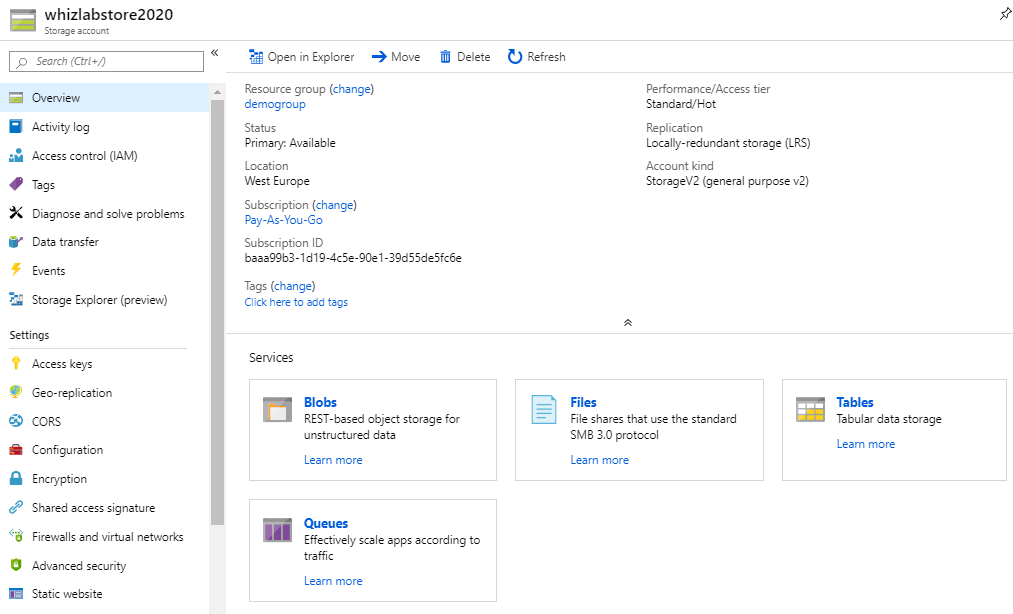
You have to complete the below command to copy all of the objects in the local folder

Which of the following would go into Slot1?
- A. https://whizlabstore2020.blob.core.windows.net/demo
- B. https://whizlabstore2020/demo
- C. D:\whizlabs
- D. whizlabs
Explanation:
Answer – C
Since we need to copy objects from the local folder, we have to mention the entire local folder path.
An example of this is given in the Microsoft documentation

Since this is clearly given in the Microsoft documentation, all other options are incorrect
For more information on using the AzCopy tool, please visit the below URL
You have to implement the azcopy tool to copy objects from a local folder named D:\whizlabs to a container named “demo” within the below storage account
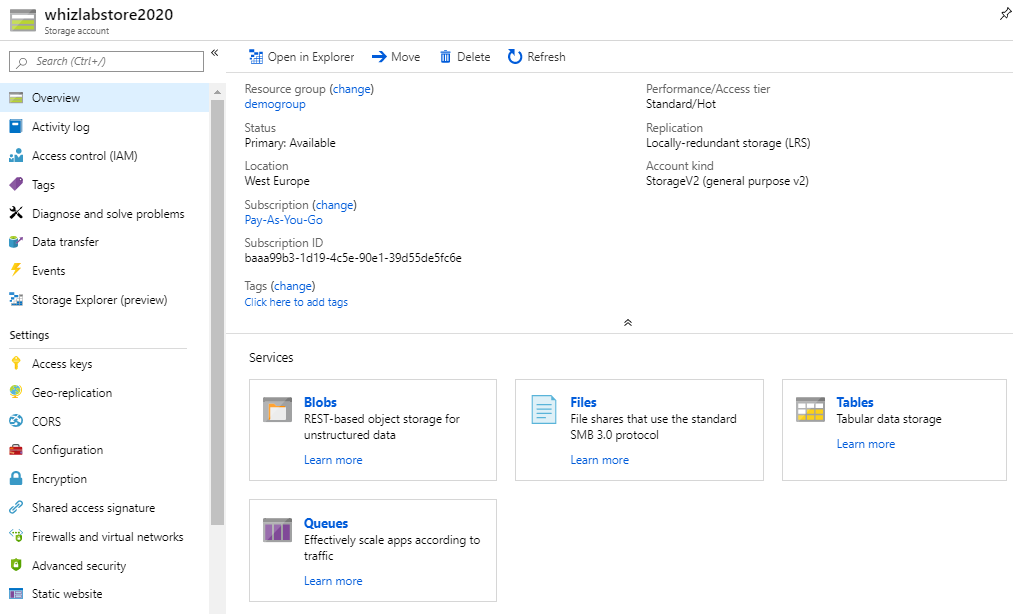
You have to complete the below command to copy all of the objects in the local folder

Which of the following would go into Slot2?
- A. https://whizlabstore2020.blob.core.windows.net/demo
- B. https://whizlabstore2020/demo
- C. D:\whizlabs
- D. whizlabs
Explanation:
Answer – A
Here since we need to copy it to the container, we have to mention the full URI of the container
An example of this is given in the Microsoft documentation

Since this is clearly given in the Microsoft documentation, all other options are incorrect
For more information on using the AzCopy tool, please visit the below URL
You have to implement the azcopy tool to copy objects from a local folder named D:\whizlabs to a container named “demo” within the below storage account
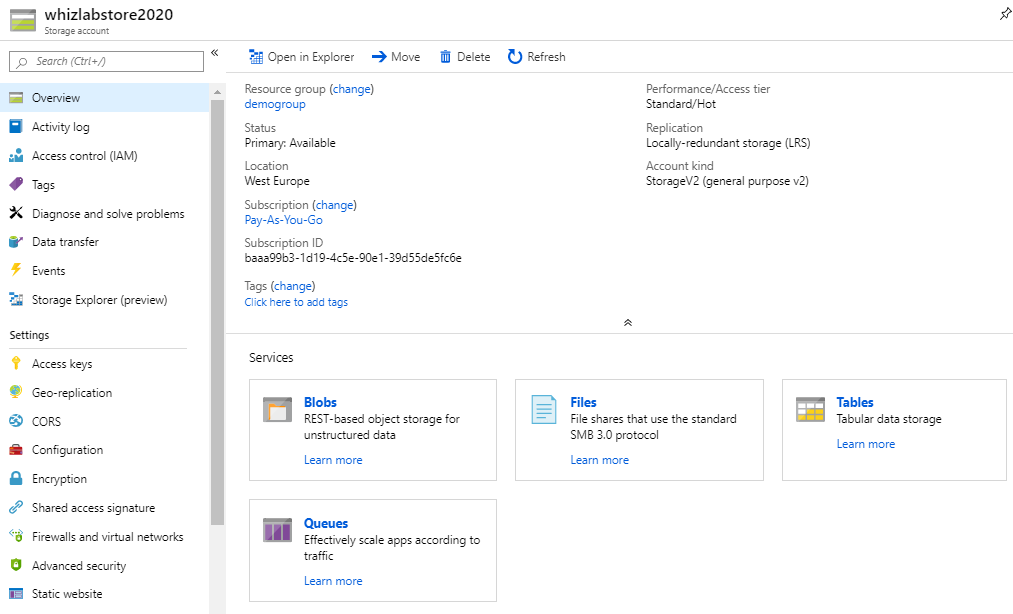
You have to complete the below command to copy all of the objects in the local folder

Which of the following would go into Slot3?
- A. --copy-all
- B. --recursive=true
- C. --tree=true
- D. --copy-files=true
Explanation:
Answer – B
Here the option for copying all the files recursively is --recursive=true
An example of this is given in the Microsoft documentation

Since this is clearly given in the Microsoft documentation, all other options are incorrect
For more information on using the AzCopy tool, please visit the below URL
You need to formulate a query that would be used to get all items from container customer where the order price is $9.99

Which of the following would go into Slot1?
- A. orders
- B. customer
- C. course
- D. customer.orders
Explanation:
Answer – D
We can use the IN clause to query data from JSON arrays
An example of an implementation of querying the data is given below
Data in the container
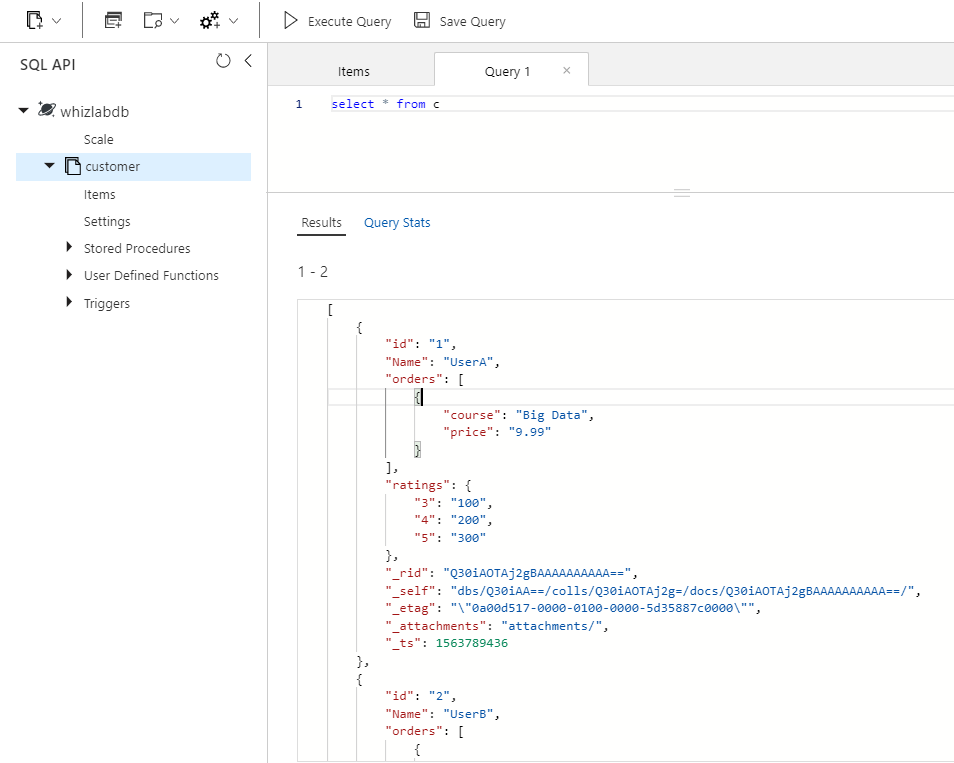
After executing the query
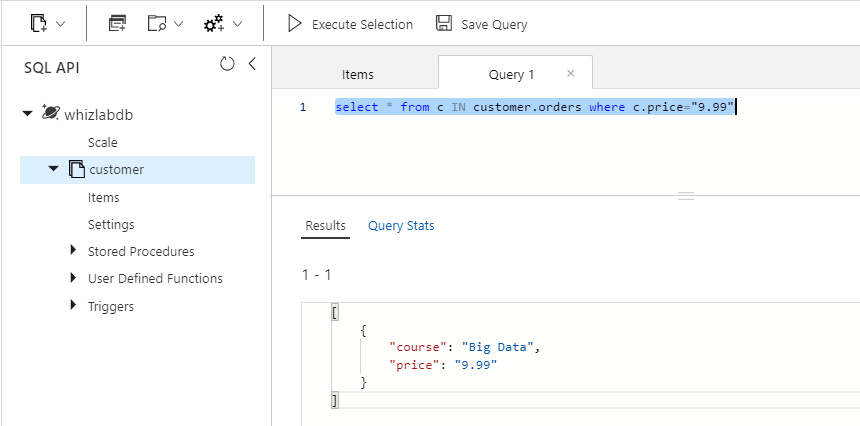
Since this is clear from the implementation, all other options are invalid
For more information on SQL queries for array objects, please visit the below URL
You need to formulate a query that would be used to get all items where the order price is $9.99

Which of the following would go into Slot2?
- A. orders
- B. course
- C. c.price
- D. c.orders
Explanation:
Answer – C
Here since we need to filter based on the price, we should use the where clause to query based on the price
An example of an implementation of querying the data is given below
Data in the container
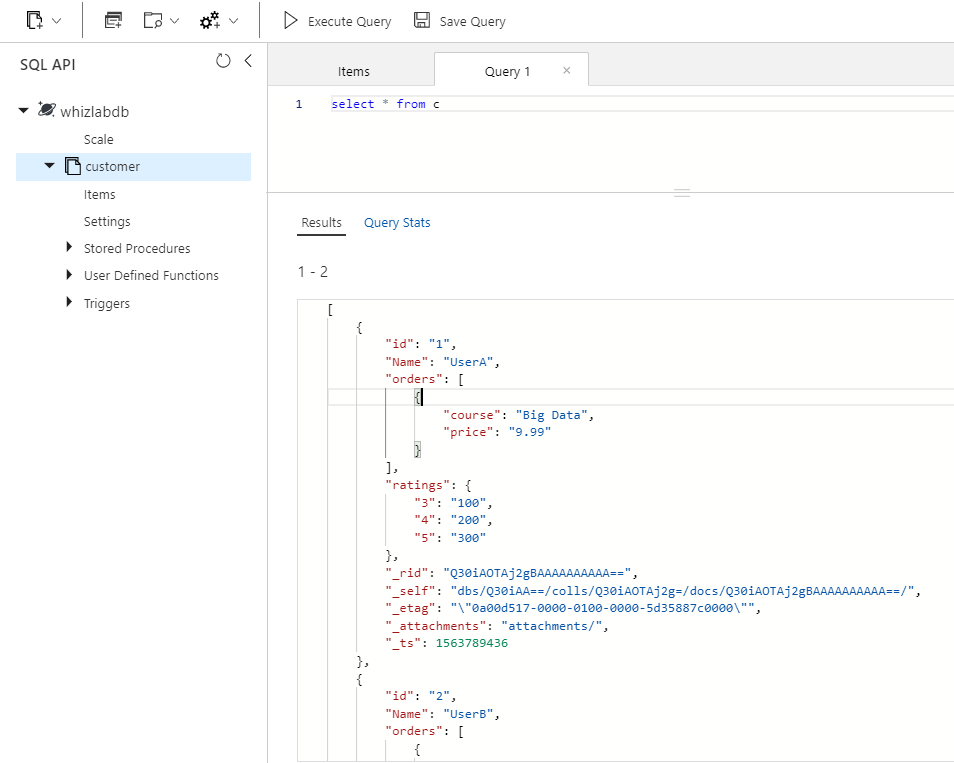
After executing the query

Since this is clear from the implementation, all other options are invalid
For more information on working with the WHERE clause, please visit the below URL
You have to update the below code snippet that would be used to upload images to the Blob container.

Which of the following would go into Slot1?
- A. BlobClient
- B. BlockBlob
- C. CloudBlob
- D. Blob
Explanation:
Answer – A
The right data type is “BlobClient”
The Microsoft documentation gives an example of uploading content to Blob containers
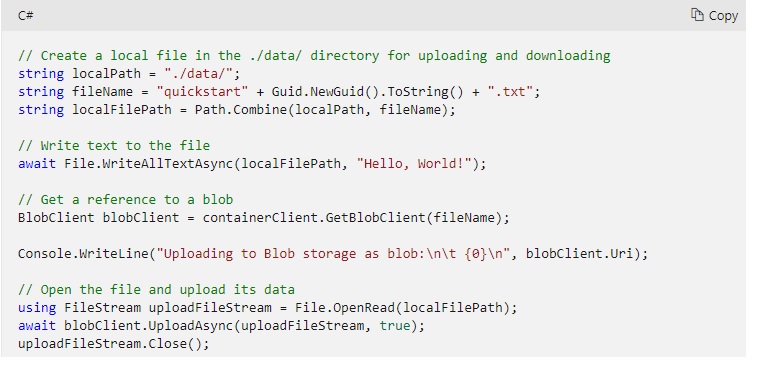
Since this is clear from the Microsoft documentation, all other options are incorrect
For more information on working with the Blob service from .Net, please visit the below URL
You have to update the below code snippet that would be used to upload images to the Blob container.
Which of the following would go into Slot2?

- A. whizlabcloudBlockBlob
- B. BlockBlob
- C. CloudBlockBlob
- D. Blob
Explanation:
Correct Answer - A
whizlabcloudBlockBlob is an instance of the class object CloudBlockBlob
The Microsoft documentation gives an example on uploading content to Blob containers
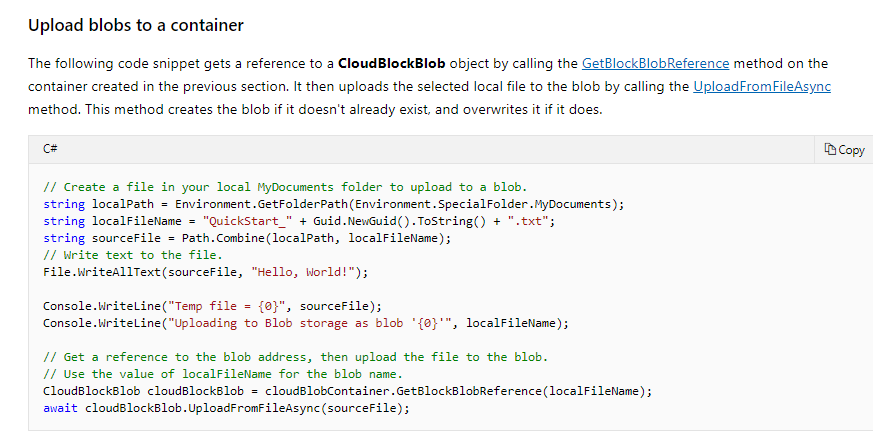
Since this is clear from the Microsoft documentation, all other options are incorrect
For more information on working with the Blob service from .Net, please visit the below URL
The Azure Web App needs to be running at all times. You have to ensure the most effective plan is assigned to the Azure Web App.
You decide to make the Azure Web App part of the “Shared” App Service Plan?
Would this fulfil the requirement?
- A. Yes
- B. No
Explanation:
Answer – B
To fulfil this requirement, the App service plan must support the “Always On” feature. And this is not supported with the Shared App Service Plan
Below is the snippet of the features of the various App Service Plans

For more information on the App Service Plans, please visit the below URL
Whizlabs is planning to deploy an application in Azure Web App and the application needs to be running at all times. You as an Azure Developer have to suggest the most effective plan to deploy the application in Azure Web App.
You suggested a “Basic” App Service Plan?
Would your suggestion fulfill the requirement?
- A. Yes
- B. No
Explanation:
Answer – A
To fulfill this requirement, the App service plan must support the “Always On” feature. And this is supported with the Basic App Service Plan
"Always On" is available only in the following 4 plans.
Basic, Standard, Premium (v3), Isolated
Below is the snippet of the features of the various App Service Plans

For more information on the App Service Plans, please visit the below URL
The Azure Web App needs to be running at all times. You have to suggest the most cost effective plan for the Azure Web App.
You recommended “Standard” as Web App Service Plan.
Would this fulfil the requirement?
- A. Yes
- B. No
Explanation:
Answer – B
To fulfil this requirement, the App service plan must support the “Always On” feature. And this is supported with the Standard App Service Plan. But this is not the most cost-effective App Service plan. Since the Basic App Service Plan already has this feature, you should choose that plan to cut on costs.
Below is the snippet of the features of the various App Service Plans

For more information on the App Service Plans, please visit the below URL
A developer needs to enable Application Insights Profiler for the Azure Web App. Which of the following feature is required to enable Application Insights Profiler for a Web App?
- A. CORS configuration
- B. Always On setting
- C. Enable Identity
- D. Enable Custom domains
Explanation:
Answer - B
The requirement is to enable Application Insights Profiler for a web app which captures the data automatically at scale without negatively affecting to end-user and widely used for monitoring purpose. and the given options are
A. CORS configuration
- Cross-origin resource sharing (CORS) defines a way for client web applications that are loaded in one domain to interact with resources
- Hence this is not going to help us to enable Application Insights Profiler
B. Always On setting
- If a web app sits idle for too long, the system unloads the website, and when traffic returns, the system needs to load the Web App which causes longer response time and higher utilization of resources. By enabling the 'Always On' setting (available for Standard tier websites), keeps the Web App up and running, which translates to higher availability and faster response times across the board.
- Since the requirement is to enable 'Application Insights Profiler' for a web App, Enabling 'Always On' is the correct prerequisite.
- Hence this is the correct answer. We recommend you find detail at https://docs.microsoft.com/en-us/azure/azure-monitor/app/profiler
C. Enable Identity
- identity is part of Azure Active Directory hence not related to Application Insights Profiler
D. Enable Custom domains
- Enable Custom Domain is a feature to access any Azure URI by different or customized URI. Hence this is not related to enabling Application Insights Profiler
We have to enable the “Always On” setting.
This is also given in the Microsoft documentation
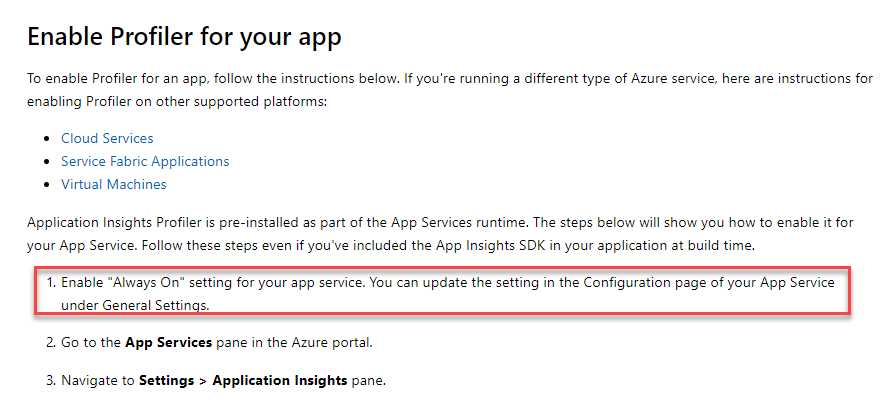
Since this is clearly given in the documentation, all other options are incorrect
For more information on enabling Application Insights for the Azure Web App, please visit the below URL
A lease needs to be applied on common blob’s in the Azure storage account.
How would you complete the below REST API call for implementing a blob lease?
https://whizlabstore2020.blob.core.windows.net/demo/whizlabcommon.json?

Which of the following should go into Slot1?
- A. getlease
- B. comp=lease
- C. get=lease
- D. obj=lease
Explanation:
Answer - B
We have to use the query string parameter as “comp=lease”
This is also given in the Microsoft documentation

Since this is clearly given in the documentation, all other options are incorrect
For more information on working with Blob lease, please visit the below URL
A company is developing a series of applications. Each of these applications would be interacting with separate Azure CosmosDB accounts. Each application has a different requirement when it comes to accessing the underlying data. You have to set the consistency level for the Azure CosmosDB accounts based on each application requirement. You have to choose the most cost-effective consistency level for each CosmosDB account. Below are the requirements for each application when it comes to the consistency of the underlying data
|
Application Name |
Data requirement |
|
whizlabappA |
This is not a critical application hence here no ordering of reads is required. |
|
whizlabappB |
Here the application uses must never see out-of-order writes |
|
whizlabappC |
Here the users must always see the latest committed write. |
|
whizlabappD |
Here the data can be stale by at most 2 versions |
Which of the following would you choose as the consistency level for the CosmosDB account used by the application “whizlabappA”?
- A. Strong
- B. Bounded Staleness
- C. Session
- D. Consistent prefix
- E. Eventual
Explanation:
Answer – E
Since the requirement is that the users don’t mind seeing out of order reads, one can use the Eventual consistency level as the most cost-effective consistency level for the CosmosDB account.
The Microsoft documentation mentions the following
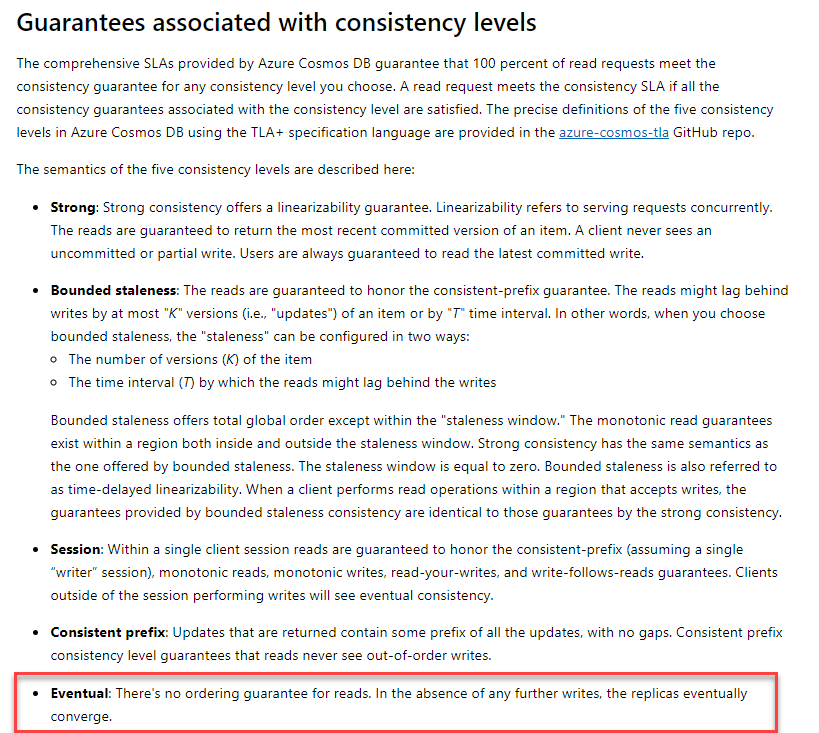
Since this is clearly given in the documentation, all other options are incorrect
For more information on CosmosDB consistency levels, one can go to the below URL
A company is developing a series of applications. Each of these applications would be interacting with separate Azure CosmosDB accounts. Each application has a different requirement when it comes to accessing the underlying data. You have to set the consistency level for the Azure CosmosDB accounts based on each application requirement. You have to choose the most cost-effective consistency level for each CosmosDB account. Below are the requirements for each application when it comes to the consistency of the underlying data
|
Application Name |
Data requirement |
|
whizlabappA |
This is not a critical application hence here no ordering of reads is required. |
|
whizlabappB |
Here the application users must never see out-of-order writes |
|
whizlabappC |
Here the users must always see the latest committed write. |
|
whizlabappD |
Here the data can be stale by at most 2 versions |
Which of the following would you choose as the consistency level for the CosmosDB account used by the application “whizlabappB”?
- A. Strong
- B. Bounded Staleness
- C. Session
- D. Consistent prefix
- E. Eventual
Explanation:
Answer - D
Since here the requirement is that the user must never see out-of-order writes, the most cost-effective option is to use the “Consistent prefix” consistency level.
The Microsoft documentation mentions the following
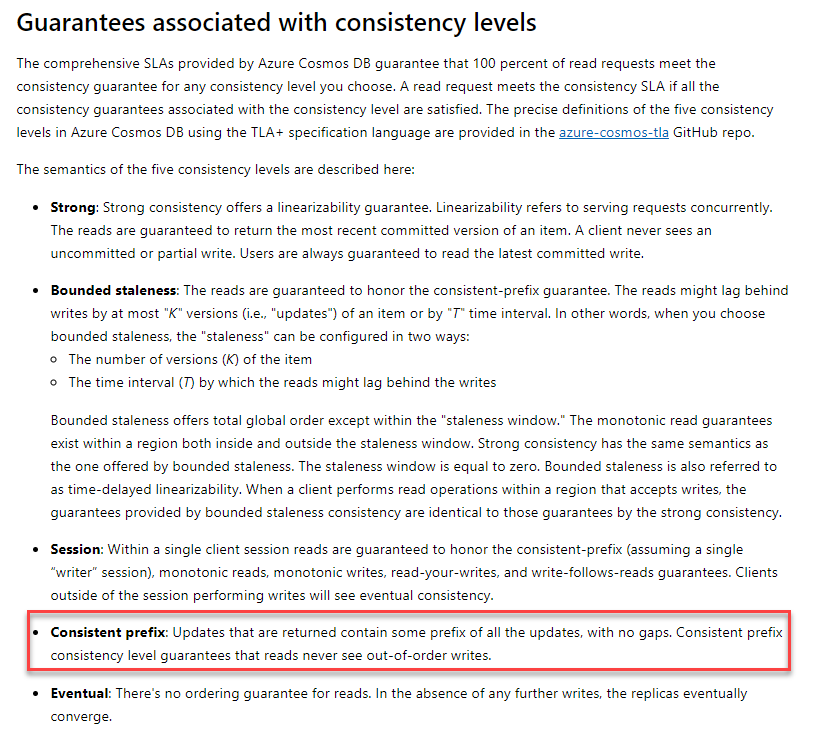
Since this is clearly given in the documentation, all other options are incorrect
For more information on CosmosDB consistency levels, one can go to the below URL
A company is developing a series of applications. Each of these applications would be interacting with separate Azure CosmosDB accounts. Each application has a different requirement when it comes to accessing the underlying data. You have to set the consistency level for the Azure CosmosDB accounts based on each application requirement. You have to choose the most cost-effective consistency level for each CosmosDB account. Below are the requirements for each application when it comes to the consistency of the underlying data
|
Application Name |
Data requirement |
|
whizlabappA |
This is not a critical application hence here no ordering of reads is required. |
|
whizlabappB |
Here the application uses must never see out-of-order writes |
|
whizlabappC |
Here the users must always see the latest committed write. |
|
whizlabappD |
Here the data can be stale by at most 2 versions |
Which of the following would you choose as the consistency level for the CosmosDB account used by the application “whizlabappC”?
- A. Strong
- B. Bounded Staleness
- C. Session
- D. Consistent prefix
- E. Eventual
Explanation:
Answer – A
Since here we need to ensure that the user always sees the latest committed version, we have to choose the “Strong” consistency level.
The Microsoft documentation mentions the following
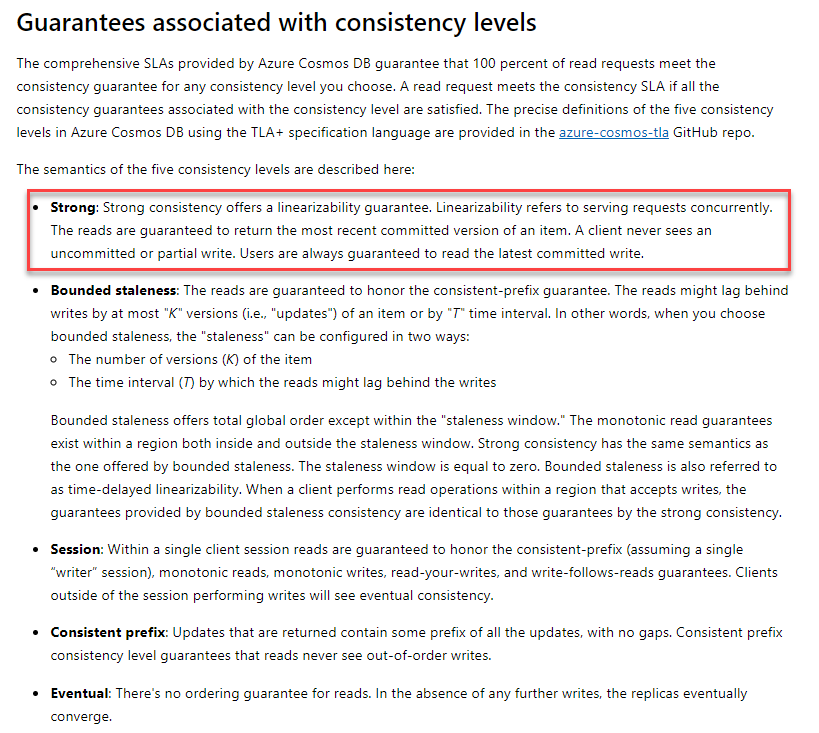
Since this is clearly given in the documentation, all other options are incorrect
For more information on CosmosDB consistency levels, one can go to the below URL
A company is developing a series of applications. Each of these applications would be interacting with separate Azure CosmosDB accounts. Each application has a different requirement when it comes to accessing the underlying data. You have to set the consistency level for the Azure CosmosDB accounts based on each application requirement. You have to choose the most cost-effective consistency level for each CosmosDB account. Below are the requirements for each application when it comes to the consistency of the underlying data
|
Application Name |
Data requirement |
|
whizlabappA |
This is not a critical application hence here no ordering of reads is required. |
|
whizlabappB |
Here the application uses must never see out-of-order writes |
|
whizlabappC |
Here the users must always see the latest committed write. |
|
whizlabappD |
Here the data can be stale by at most 2 versions |
Which of the following would you choose as the consistency level for the CosmosDB account used by the application “whizlabappD”?
- A. Strong
- B. Bounded Staleness
- C. Session
- D. Consistent prefix
- E. Eventual
Explanation:
Answer – B
Here since we have a staleness of data by a set version count, we can use the Bounded staleness consistency level.
The Microsoft documentation mentions the following
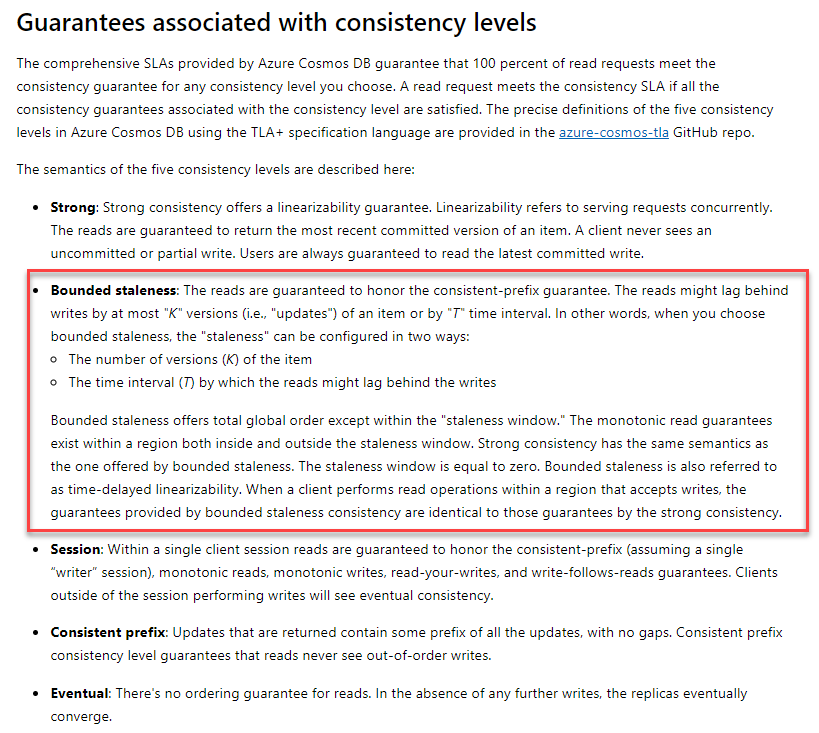
Since this is clearly given in the documentation, all other options are incorrect
For more information on CosmosDB consistency levels, one can go to the below URL
A company has a web application deployed to Azure. The web application is currently being hosted as part of the Azure Web App service. There is a requirement to stream the logs from the web app and filter out on any errors.
You have to complete the below Azure CLI command for this requirement

Which of the following would go into Slot1?
- A. file
- B. log
- C. tail
- D. stream
Explanation:
Answer – B
Since we need to get the log files for the Azure Web app, we have to use the “log” option in the command.
An example of this is also given in the Microsoft documentation
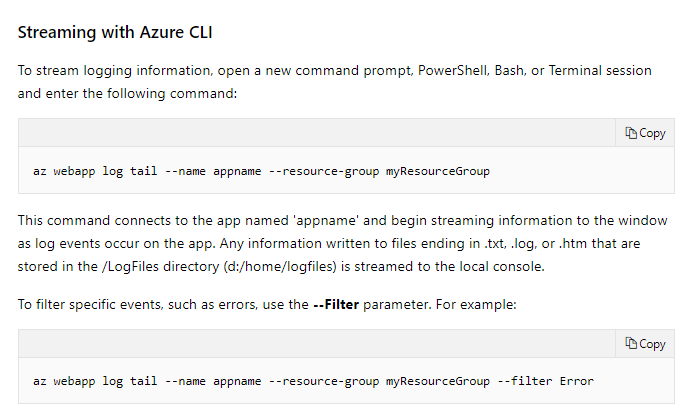
Since this is clearly given in the documentation, all other options are incorrect
For more information on working with diagnostics logs, one can go to the below URL
A company has a web application deployed to Azure. The web application is currently being hosted as part of the Azure Web App service. There is a requirement to stream the logs from the web app and filter out on any errors.
You have to complete the below Azure CLI command for this requirement

Which of the following would go into Slot2?
- A. file
- B. log
- C. tail
- D. stream
Explanation:
Answer – C
Since we need to stream the log files , the next option to include is the “tail” option
An example of this is also given in the Microsoft documentation
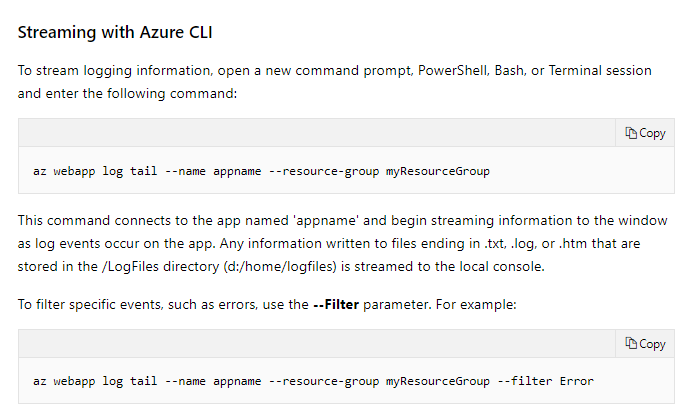
Since this is clearly given in the documentation, all other options are incorrect
For more information on working with diagnostics logs, one can go to the below URL
A company has a web application deployed to Azure. The web application is currently being hosted as part of the Azure Web App service. There is a requirement to stream the logs from the web app and filter out on any errors.
You have to complete the below Azure CLI command for this requirement

Which of the following would go into Slot3?
- A. --path
- B. --only-show-
- C. --key
- D. --type
Explanation:
Answer – B
Since we have the filter out on the errors, we can use the filter option for the command.
An example of this is also given in the Microsoft documentation
--------------------
az webapp log tail [--ids]
[--name]
[--provider]
[--resource-group]
[--slot]
[--subscription]
Optional Parameters
--ids
One or more resource IDs (space-delimited). It should be a complete resource ID containing all information of 'Resource Id' arguments. You should provide either --ids or other 'Resource Id' arguments.
--name -n
Name of the web app. If left unspecified, a name will be randomly generated. You can configure the default using az configure --defaults web=<name>.
--provider
By default all live traces configured by az webapp log config will be shown, but you can scope to certain providers/folders, e.g. 'application', 'http', etc. For details, check out https://github.com/projectkudu/kudu/wiki/Diagnostic-Log-Stream.
--resource-group -g
Name of resource group. You can configure the default group using az configure --defaults group=<name>.
--slot -s
The name of the slot. Default to the productions slot if not specified.
--subscription
Name or ID of subscription. You can configure the default subscription using az account set -s NAME_OR_ID.
Global Parameters
--debug
Increase logging verbosity to show all debug logs.
--help -h
Show this help message and exit.
--only-show-errors
Only show errors, suppressing warnings.
--output -o
Output format.
--query
JMESPath query string. See http://jmespath.org/ for more information and examples.
--verbose
Increase logging verbosity. Use --debug for full debug logs.
----------------------------
Since this is clearly given in the documentation, all other options are incorrect
For more information on working with diagnostics logs, one can go to the below URL
A team has to integrate various modules of an application with the Azure Event Grid service. They have to filter events which are sent to the various application endpoints. The requirements for the type of messages that need to be received by the different endpoints are given below
|
Application Endpoint |
Message requirement |
|
EndpointA |
Receives failure messages for any resources deployed to the Azure subscription |
|
EndpointB |
Receives messages whenever objects are added to a specific container in Azure Blob storage |
|
EndpointC |
Receive messages whenever data fields in the message has the value of “Organization” |
Which of the following would you use as a filter option for messages that need to be sent to EndpointA?
- A. Subject begins with or ends with
- B. Advanced fields and operators
- C. ResourceTypes
- D. EventTypes
Explanation:
Answer - D
Since here we just need to filter on the event types itself, we can use the “EventTypes” filter.
The Microsoft documentation mentions the following
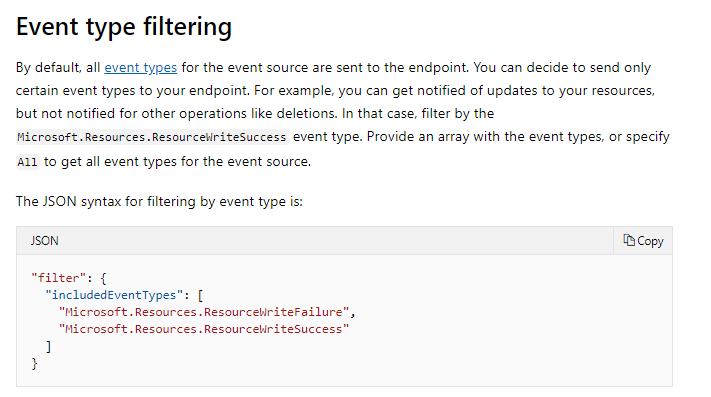
Since this is clearly given in the documentation, all other options are incorrect
For more information on event filtering in Azure Event Grid, one can go to the below URL
A team has to integrate various modules of an application with the Azure Event Grid service. They have to filter events which are sent to the various application endpoints. The requirements for the type of messages that need to be received by the different endpoints are given below
|
Application Endpoint |
Message requirement |
|
EndpointA |
Receives failure messages for any resources deployed to the Azure subscription |
|
EndpointB |
Receives messages whenever objects are added to a specific container in Azure Blob storage |
|
EndpointC |
Receive messages whenever data fields in the message has the value of “Organization” |
Which of the following would you use as a filter option for messages that need to be sent to EndpointB?
- A. Subject begins with or ends with
- B. Advanced fields and operators
- C. ResourceTypes
- D. EventTypes
Explanation:
Answer – A
Since here we need to check on the messages sent to a container, so we have to check the subject of the message
The Microsoft documentation mentions the following
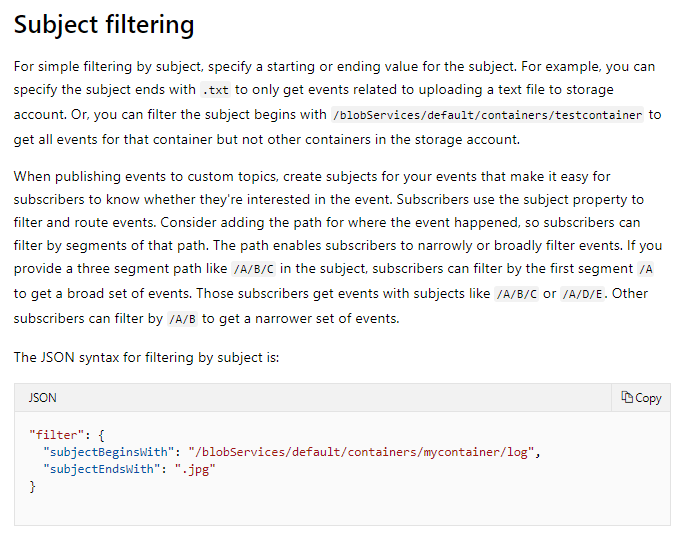
Since this is clearly given in the documentation, all other options are incorrect
For more information on event filtering in Azure Event Grid, one can go to the below URL
A team has to integrate various modules of an application with the Azure Event Grid service. They have to filter events which are sent to the various application endpoints. The requirements for the type of messages that need to be received by the different endpoints are given below
|
Application Endpoint |
Message requirement |
|
EndpointA |
Receives failure messages for any resources deployed to the Azure subscription |
|
EndpointB |
Receives messages whenever objects are added to a specific container in Azure Blob storage |
|
EndpointC |
Receive messages whenever data fields in the message has the value of “Organization” |
Which of the following would you use as a filter option for messages that need to be sent to EndpointC?
- A. Subject begins with or ends with
- B. Advanced fields and operators
- C. ResourceTypes
- D. EventTypes
Explanation:
Answer – B
Here since we need a more advanced scenario and check for the data field values, we have to choose the “Advanced fields and operators” filter option
The Microsoft documentation mentions the following
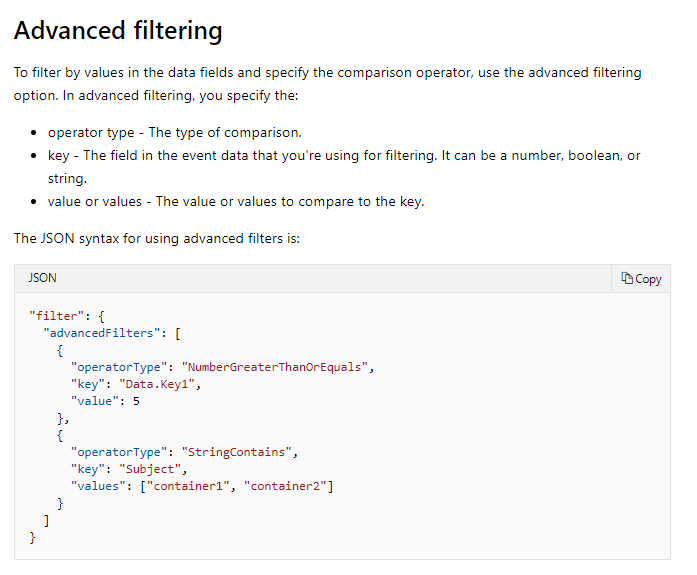
Since this is clearly given in the documentation, all other options are incorrect
For more information on event filtering in Azure Event Grid, one can go to the below URL
A development team have deployed an API management instance. An application sits behind the API management instance. The application accepts all data in JSON format. An external consultant currently connects to the API management instance. The data sent by the external consultant is in XML format.
You have to ensure the data gets converted to JSON by the API management instance.
You decide to implement an API management policy.
Would this fulfil the requirement?
- A. Yes
- B. No
Explanation:
Answer – A
You can use a policy to convert the data.
The Microsoft documentation mentions the following
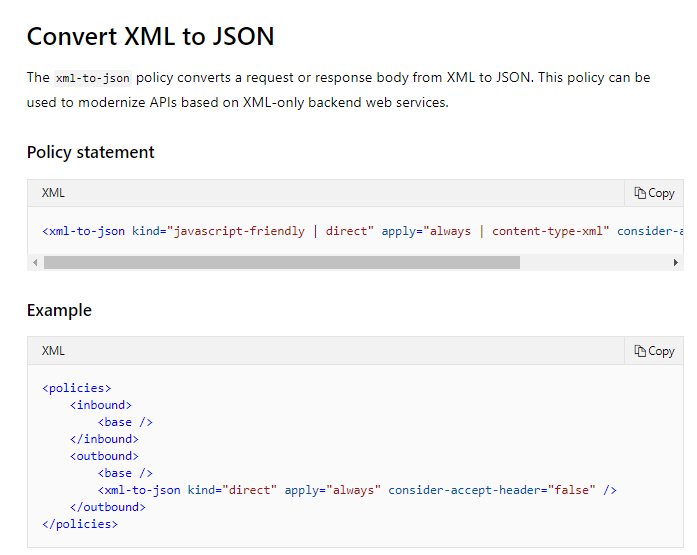
For more information on API management policies, one can go to the below URL
A development team have deployed an API management instance. An application sits behind the API management instance. The application accepts all data in JSON format. An external consultant currently connects to the API management instance. The data sent by the external consultant is in XML format.
You have to ensure the data gets converted to JSON by the API management instance.
You decide to create an Azure Event Hub namespace.
Would this fulfil the requirement?
- A. Yes
- B. No
Explanation:
Answer – B
The Azure Event Hub could be used to log events from the Azure API Management instance
For more information on logging to Azure Event Hubs, one can go to the below URL
A development team have deployed an API management instance. An application sits behind the API management instance. The application accepts all data in JSON format. An external consultant currently connects to the API management instance. The data sent by the external consultant is in XML format.
You have to ensure the data gets converted to JSON by the API management instance.
You decide to implement RBAC.
Would this fulfil the requirement?
- A. Yes
- B. No
Explanation:
Answer – B
RBAC is used to provide Role Based Access Control in Azure API Management
For more information on role-based access control for Azure API management, one can go to the below URL
A development team needs to develop an application module that needs to interact with an Azure service bus queue.
Below is the snippet of code that needs to be completed. The code is used to send a message to the queue.

Which of the following needs to go into Slot1?
- A. Client
- B. ServiceBusClient
- C. QueueClient
- D. BusClient
Explanation:
Answer – C
Since we need to interact with a queue, we have to use the “QueueClient” class.
An example of this is given in the Microsoft documentation
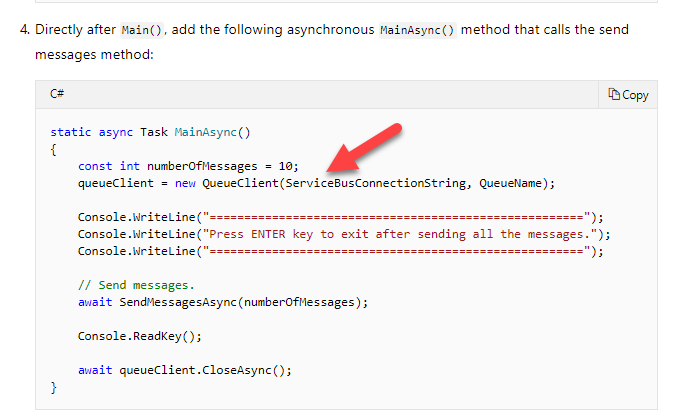
Since this is clearly given in the documentation, all other options are incorrect
For more information on working with queues in .Net, one can go to the below URL
A development team needs to develop an application module that needs to interact with an Azure service bus queue.
Below is the snippet of code that needs to be completed. The code is used to send a message to the queue.
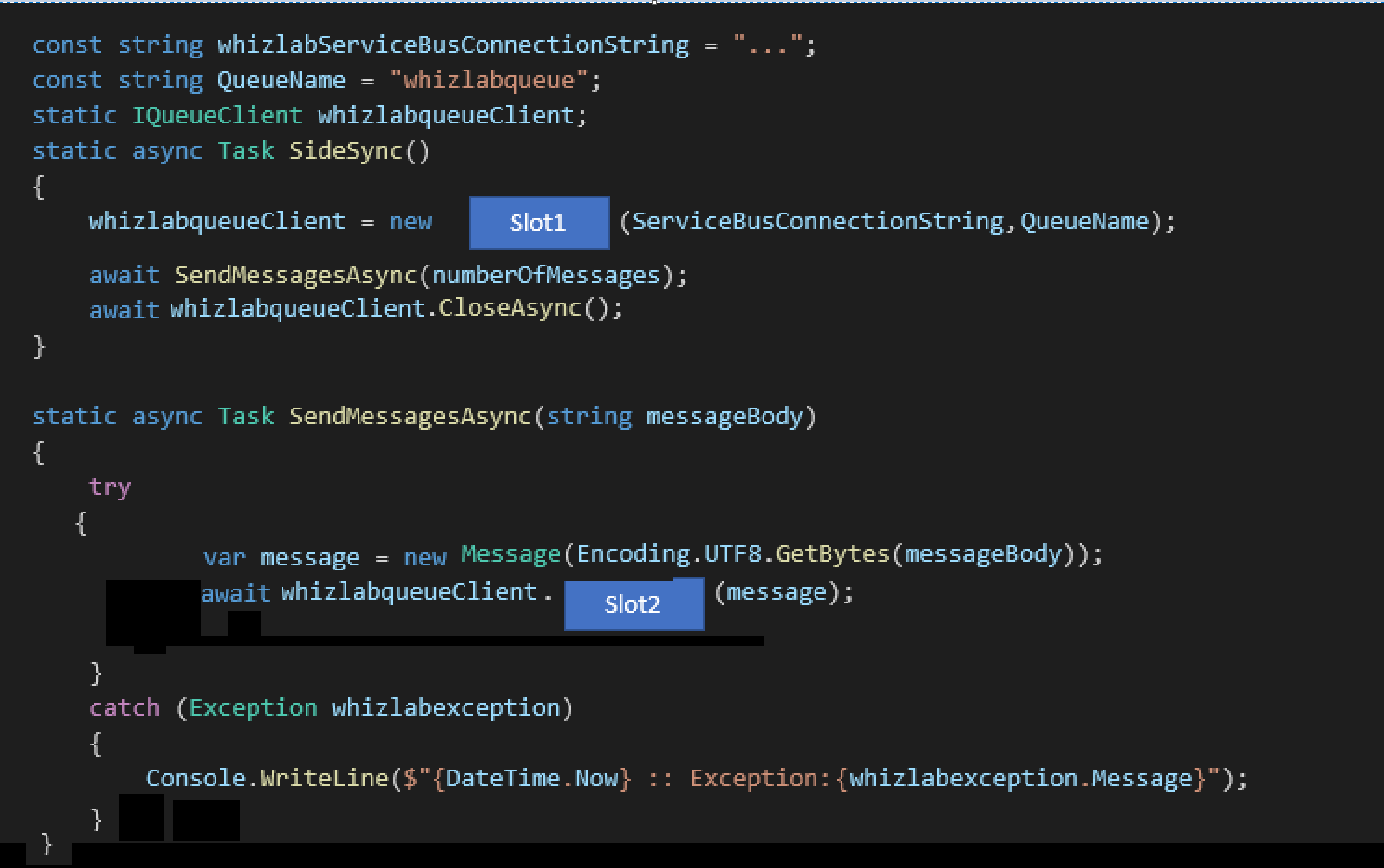
Which of the following needs to go into Slot2?
- A. Send
- B. SendMessage
- C. SendAsync
- D. GetAsync
Explanation:
Answer – C
To send a message asynchronously, we have to use the “SendAsync” method.
An example of this is given in the Microsoft documentation
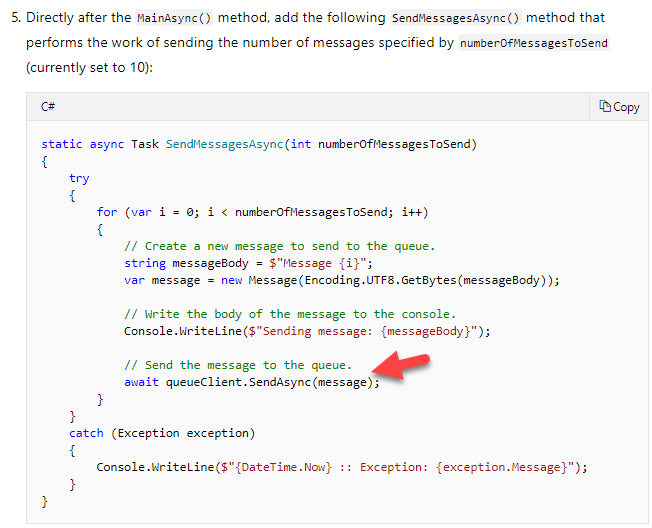
Since this is clearly given in the documentation, all other options are incorrect
For more information on working with queues in .Net, one can go to the below URL
You have an Azure key vault in a place named whizlabvault9000. You have to add a secret to the vault. Which of the following commands would you issue for this requirement?
- A. az secret value set
- B. az keyvault secret set
- C. az secret set
- D. az secret key set
Explanation:
Correct Answer – B
You have to issue the “az keyvault secret set” command.
An example is also given in the Microsoft documentation
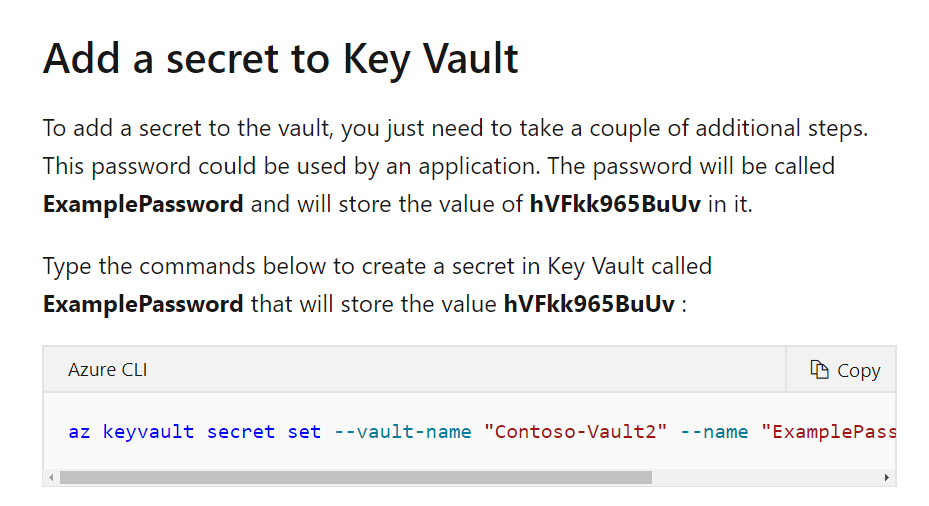
Since this is clearly given in the documentation, all other options are incorrect.
For more information on working with secrets in the key vault, please visit the following URL

